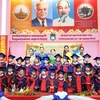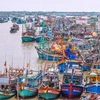Located 50km north of Hanoi, Bac Giang province is considered to be well-suited to develop tourism, especially due to its good transport connections, including road, railway and waterway infrastructure.
Bac Giang province boasts a wealth of historical and cultural tradition with around 2,230 relic sites, including Vinh Nghiem pagoda where Truc Lam, the Zen Buddhist sect, was founded by King Tran Nhan Tong in the 13th century. The pagoda in Yen Dung district now preserves more than 3,000 woodblocks, which were recognised as a world heritage.
Quan Ho (love duet singing) and Ca Tru (ceremonial signing) singing were recognised as intangible cultural heritage by UNESCO.
In addition to its 500 traditional festivals held every year, the province preserves a number of ethnic minority cultural practices, such as the San Chi, the Cao Lan, the Nung, and the Tay.
Bac Giang is also renowned for its traditional craft villages along the north bank of the Cau River, such as Tho Ha ceramics, Van wine making and local specialities.
Apart from its geographic advantage located in the midst of the country’s major economic development-tourism centres such as Hanoi, Hai Phong, Quang Ninh, Lang Son and Thai Nguyen, Bac Giang is endowed with beautiful landscapes, like the Suoi Mo eco-tourism site, Khuon Than and Cam Son lakes, West Yen Tu nature reserve, and the Khe Ro primary forest with its diverse flora and fauna.
Aware of the role that the tourism industry plays in socio-economic development, Bac Giang has carried out a number of programmes, projects and master plans on the development of tourism with a vision to 2030, including plans for the conservation of relics and nature reserves, personnel training and tourism promotion.
The province spent nearly 100 billion VND from its own budget and mobilised tens of billions VND from the public to restore and upgrade cultural-historical relics as well as preserving different art forms and intangible cultural heritage, creating a basis for the sector’s development.
Thanks to these efforts, the number of visitors to the province has increased, with an annual growth rate of 12-15 percent in recent years.
However, tourism in Bac Giang has not yet reached its full potential due to inappropriate investment; a lack of tourism agencies, human resources, and specific tourism products; and poor infrastructure.
To create breakthroughs in tourism development, Bac Giang has set out a catalogue of measures for the near future, including implementing planning and managing projects, enhancing tourism linkages, strengthening communication and promotion efforts, developing tourism products and human resources, and preserving culture and creating incentives.
Bac Giang aims to welcome more than 400,000 tourists in 2015, creating jobs for nearly 4,000 labourers and contributing to socio-economic development in the province.-VNA



















